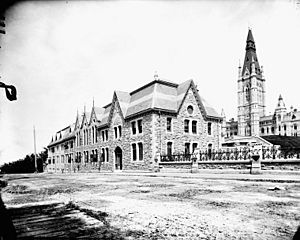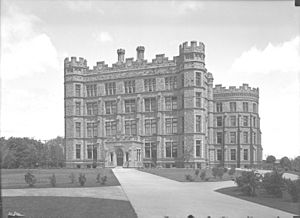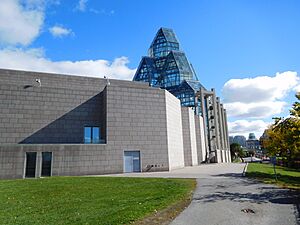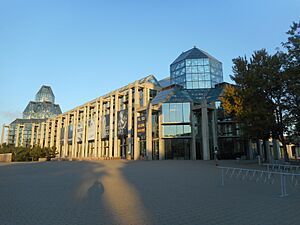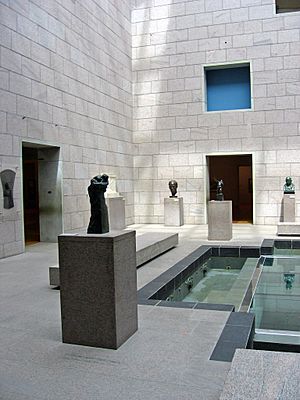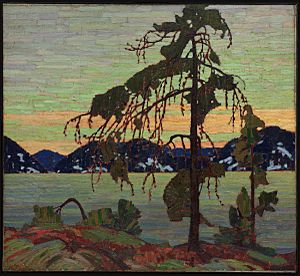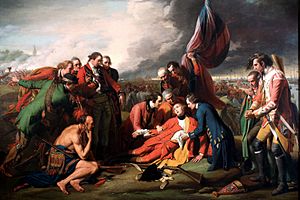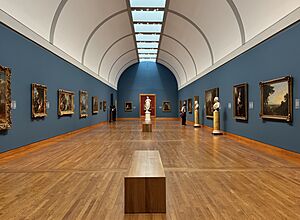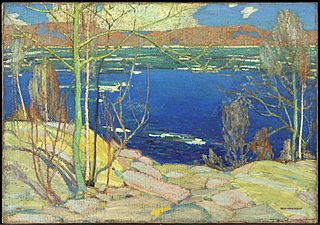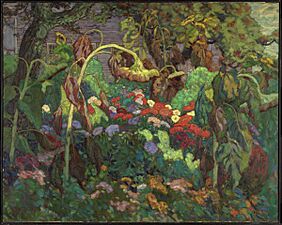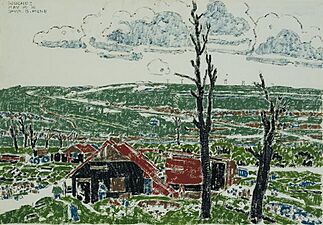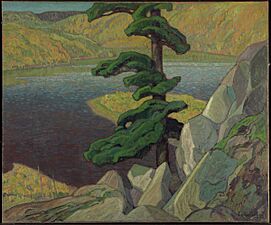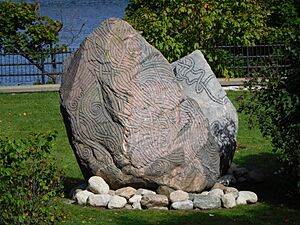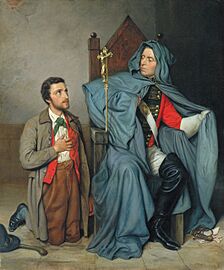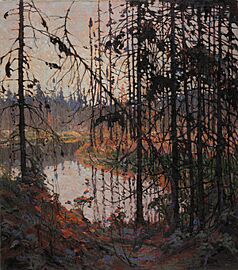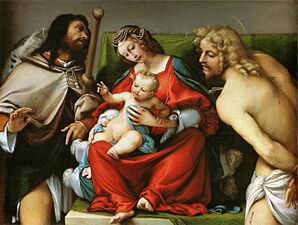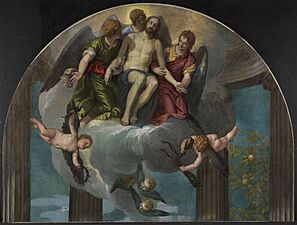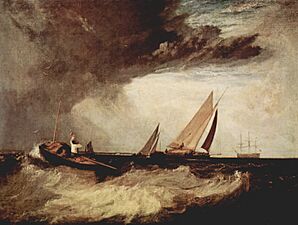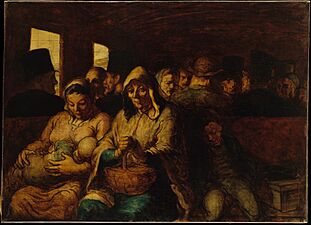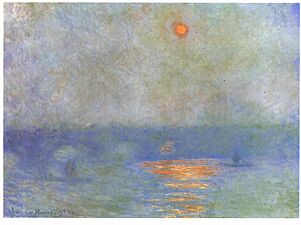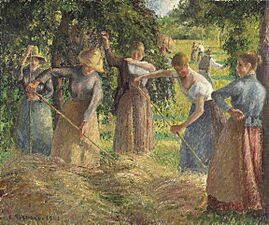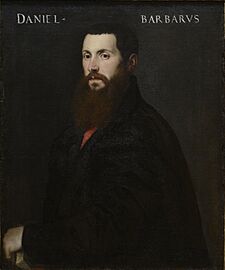National Gallery of Canada facts for kids
 |
|
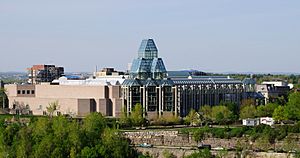
National Gallery of Canada
|
|
| Established | 1880 |
|---|---|
| Location | |
| Type | Art museum |
| Collection size | 93,625 |
| Visitors | 385,576 (FY2017–18) |
| Architect | Moshe Safdie (1983) |
| Public transit access | [[|9]] Rideau/Hurdman |
The National Gallery of Canada (French: Musée des beaux-arts du Canada) is Canada's national art museum. It is located in Ottawa, the capital city of Ontario. The museum building is very large, with about 12,400 square meters (133,000 square feet) of space just for showing art. This makes it one of the biggest art museums in North America.
The museum first opened in 1880. It moved to a new building in 1911. In 1913, the Canadian government passed a law called the National Gallery Act. This law officially made the Gallery Canada's national art museum. In 1988, the Gallery moved to its current special building. This building was designed by an architect named Moshe Safdie. It is made of glass and granite and has a great view of Canada's Parliament Buildings.
The Gallery has a huge collection of over 93,000 artworks. These works are by artists from Europe, America, Asia, Canada, and Indigenous communities. Besides showing its own collection, the Gallery also sends its art to other museums for special shows.
Contents
History of the National Gallery
The National Gallery of Canada started in 1880. It was created by Canada's Governor General, John Campbell, 9th Duke of Argyll. In 1882, the Gallery found its first home on Parliament Hill. It was located in the Second Supreme Court of Canada building.
Eric Brown became the first director in 1910. In 1911, the Gallery moved to the Victoria Memorial Museum building. It shared this building with the National Museum of Natural Sciences. In 1913, the first National Gallery Act was passed. This law explained what the Gallery was meant to do and how it would get money.
By the 1950s, the Victoria Memorial Museum building was not big enough for all the Gallery's art. The Gallery needed a new, permanent home. In 1960, the National Gallery moved to the Lorne Building. This building was later taken down and replaced by a new office building.
In 1982, the Canadian government decided to build new, permanent homes for its national museums. This included the National Gallery. Jean Sutherland Boggs, who was the director of the National Gallery, was chosen to lead the building project. Construction for the new museum building on Sussex Drive began in 1985. The new building officially opened in May 1988.
The National Gallery became independent again in 1987. This meant it could make its own decisions about its art and programs. The Canadian Museum of Contemporary Photography (CMCP) later joined the National Gallery. Its collection of photographs became part of the Gallery's collection in 2009.
In 2006, the Gallery returned a painting by Édouard Vuillard to its rightful owners. This painting had been taken during World War II. The Gallery works to make sure all its art was acquired fairly.
Since 2009, the National Gallery of Canada has partnered with other art galleries across Canada. This allows more people to see artworks from the National Gallery's collection. The current director and chief executive officer is Jean-François Bélisle, who was appointed in 2023.
The Museum Building
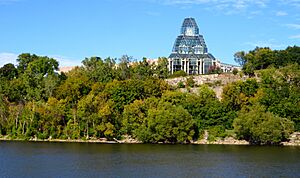
The National Gallery's current building was designed by Moshe Safdie & Associates. Construction started in 1985, and it opened in 1988. The building has a total area of about 46,621 square meters (501,820 square feet). In 2000, the Royal Architectural Institute of Canada named the National Gallery as one of the top 500 buildings in Canada from the last 1,000 years. The building is located on Sussex Drive, near the ByWard Market area.
The building was built by a special company created by the government. Even though there were some changes to the plan, the government continued to fund the building's construction.
Outside the Building
The outside of the building is made of pink granite walls and large glass windows. The southern side has a long glass wall supported by concrete pillars. This part of the building looks a bit like a Gothic cathedral. The main entrance is in a low, glass dome-like structure.
There is also a tall, three-story glass dome made of rectangular and triangular glass pieces. These pieces are held together by steel supports. This dome is placed so that when you approach the museum from the east, you can see it framed by the Peace Tower and the Library of Parliament.
Inside the Building
The entrance lobby has pink granite floors. A wide ramp slopes upwards towards the main part of the museum. The architect, Moshe Safdie, wanted visitors to feel like they were going on a special journey as they walked up the ramp. The ceiling above the ramp is made of glass and steel, also reminding visitors of a Gothic cathedral.
Inside the building, there is a special outdoor area called the Taiga Garden. This garden was designed by Cornelia Oberlander. It was inspired by a painting called Terre Sauvage by A. Y. Jackson, which is in the Gallery's collection. The garden tries to look like the taiga landscape found in the Canadian shield.
Art Collection
As of October 2018, the National Gallery of Canada has over 93,625 artworks in its permanent collection. These works cover many different art styles and time periods. The Gallery has a large and varied collection of paintings, drawings, sculptures, and photographs. The first artworks the museum bought were by Canadian artists, and Canadian art is still a main focus. However, the collection also includes many works from artists around the world.
The Gallery's collection of prints and drawings has 27,000 works on paper. These date from the 15th century to today. About 10,000 of these are by Canadian artists, including over 800 by Inuit artists. The collection also has 2,500 drawings and 10,000 prints by American, Asian, and European artists.
The Gallery also has about 400 works from Asian artists, from 200 CE to the 19th century. Many of these came from the collection of Nasli Heeramaneck. The Gallery also has a large collection of photographs. Some of these came from the former Canadian Museum of Contemporary Photography.
For a long time, the Gallery did not actively collect art by Indigenous peoples. This has changed a lot since the 1980s. The Gallery is working to show more Indigenous art, especially in its older art sections.
The largest artwork in the Gallery is the entire inside of the Rideau Street Chapel. This chapel interior was designed in 1887. The Gallery bought it in 1972 when the chapel was going to be torn down. The 1,123 pieces of the interior were taken apart, stored, and then put back together inside the Gallery in 1988.
Canadian and Indigenous Art
The Gallery's Canadian collection includes art from the 18th century to the 1990s. It has paintings from before Canada became a country, modern abstract art, and a collection of Canadian silver. The earliest Canadian artworks came from artists at the Royal Canadian Academy of Arts.
The Gallery has many works by the Group of Seven. It also has a large collection of art by Tom Thomson, including his famous painting The Jack Pine. Another artist with many works here is Alex Colville. Other Canadian artists in the collection include Emily Carr, Jean-Paul Riopelle, and Michael Snow.
In 2017, for Canada's 150th birthday, the Gallery opened a new section called "Canadian and Indigenous Art: From Time Immemorial to 1967." This section shows Canadian and Indigenous artworks side by side. It helps visitors understand how the art and history of these two groups are connected.
The Indigenous collection focuses on works by Indigenous peoples of Canada. The Gallery started collecting works by First Nations and Metis artists in the early 1900s. However, these artists were not always recognized as Indigenous at first. The Gallery started collecting Inuit art in 1956. This was partly to help create jobs in the North and show Canada's presence there.
Many Indigenous artists have their works in the collection. These include Norval Morrisseau, Kenojuak Ashevak, and Shelley Niro.
Contemporary Art
The Gallery's contemporary collection includes 1,500 works by artists from the 1990s to today. It features many works by Canadian and Indigenous artists. The first contemporary Indigenous Canadian artwork bought by the Gallery was The North American Iceberg (1985) by Ojibwe artist Carl Beam.
In 2017, a large collection of contemporary art was donated to the Gallery. It included 197 paintings, sculptures, and mixed-media pieces. Most of these were by artists from Vancouver, like Rodney Graham and Brian Jungen.
In 1990, the Gallery bought a painting called Voice of Fire by Barnett Newman. This caused some debate at the time. In 1999, the Gallery bought a huge spider sculpture called Maman by Louise Bourgeois. This sculpture is now displayed outside the museum. Other modern artists in the collection include Roxy Paine and Joe Fafard.
European, American, and Asian Art
This part of the collection includes most of the Gallery's art by non-Canadian artists. The Gallery bought its first European artwork in 1907. It was a painting called Ignatius Sancho by Thomas Gainsborough. The Gallery started collecting American art later, in the 1970s.
The collection has European and American artworks from the Renaissance period up to the 20th century. It also has 400 works from India, Nepal, and Tibet.
The Gallery's European collection has grown through purchases and gifts. For example, it has La Tour Eiffel by Marc Chagall. In 2005, the Gallery bought a painting by Italian Renaissance artist Francesco Salviati. Other famous artists in the European collection include Claude Monet, Rembrandt, and Vincent van Gogh.
Library and Archives
The National Gallery of Canada has a large library and archives. It holds many books and documents about Canadian art. The library started in 1880, at the same time as the Gallery. It has information on Western art from the Late Middle Ages to today. The collection includes 275,000 books, exhibition catalogs, and magazines. It also has many research files and photographs. The archives keep important records about the Gallery itself.
How the Gallery is Managed
The Canadian government became responsible for the Gallery in 1913. In 1990, the Gallery became a special type of organization called a Crown corporation. This means it is owned by the government but runs like a business. The Museums Act is the law that guides how the museum operates. A group of people called a board of trustees manages the Gallery. The board reports to the Minister of Canadian Heritage. The Director and CEO is in charge of the daily operations.
The Gallery works with several other organizations, like the Canadian Museums Association.
Directors of the National Gallery
- Eric Brown (1910–1939)
- Harry Orr McCurry (1939–1955)
- Alan Jarvis (1955–1959)
- Charles Comfort (1960–1965)
- Jean Sutherland Boggs (1966–1976)
- Hsio-yen Shih (1977–1981)
- Joseph Martin (1983–1987)
- Shirley Thomson (1987–1997)
- Pierre Théberge (1998–2008)
- Marc Mayer (2009–2019)
- Alexandra Sasha Suda (2019–2022)
- Angela Cassie (interim 2022–2023)
- Jean-François Bélisle (2023– )
Selected Artworks
Canadian Collection
-
Charlotte Schreiber, The Croppy Boy, 1879
European and American Collection
- Auguste Rodin, Age of Bronze, 1875–1876, cast in 1901
- Henri Matisse, Yellow Odalisque, 1926
- M. C. Escher, Stars, 1948
- Barnett Newman, Voice of Fire, 1967
-
Lorenzo Lotto, Madonna and Child with Saint Roch and Saint Sebastian, c. 1518
-
Paolo Veronese, Fragment of the Petrobelli Altarpiece: The Dead Christ with Angels, c. 1563
-
J. M. W. Turner, Shoeburyness Fishermen Hailing a Whitstable Hoy, c. 1809
-
Honoré Daumier, The Third-Class Carriage, 1863–1865
-
Claude Monet, Waterloo Bridge: the Sun in a Fog, 1903
-
Camille Pissarro, Hay Harvest at Éragny, 1901
-
Sandro Botticelli, The Triumph of Mordecai, c. 1475
-
Hans Baldung Grien - Eve, Serpent and Death.JPG
Hans Baldung, Eve, the Serpent, and Death, c. 1510–1515
-
Titian, Daniele Barbaro, 1545k
-
El Greco, St. Francis and Brother Leo Meditating on Death, c. 1600–1605
-
Peter Paul Rubens, The Entombment, c. 1612–1615
-
Rembrandt, Heroine from the Old Testament, 1632–33
-
Vincent van Gogh, Iris, 1890
-
Paul Cézanne, Forest, c. 1902–1904
-
Klimt - Hoffnung I - 1903.jpeg
Gustav Klimt, Hope I, 1903
-
Arshile Gorky, Charred Beloved II, 1946
Prints and Drawings Collection
-
Giorgio Vasari, Abraham and the Three Angels, c. 16th century
-
Caspar David Friedrich, Boy Sleeping on a Grave, c. 1801–1803
-
Eugène Delacroix, The Barque of Dante, c. 1820
-
Francisco Goya, Holy Week in Spain in Times Past, c. 1825
-
Ford Madox Brown, Portrait of Emma Madox Brown, 1853
-
John Everett Millais, Portrait of Effie Ruskin, c. 1853
-
Odilon Redon, The Raven, 1882
-
Mary Cassatt, Woman Bathing, c. 1890–1891
See also
 In Spanish: Galería Nacional de Canadá para niños
In Spanish: Galería Nacional de Canadá para niños
- List of art museums
- List of largest art museums
- List of museums in Ontario
- List of national galleries
- National museums of Canada


